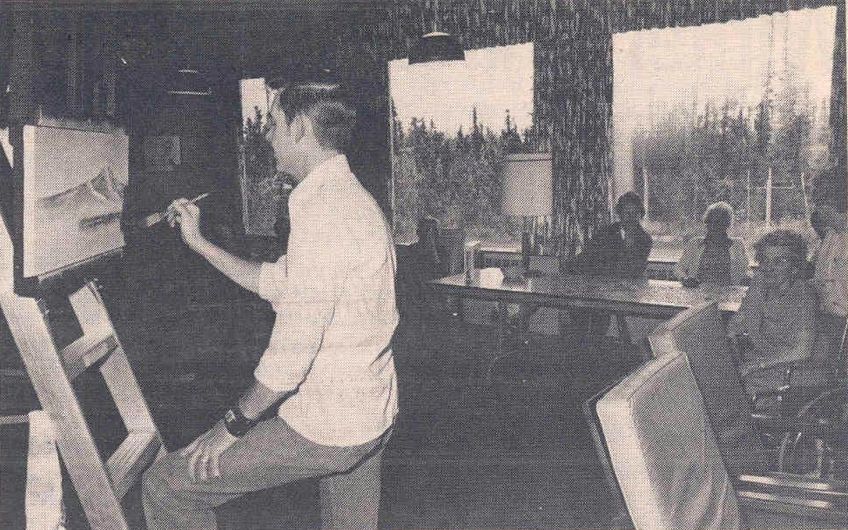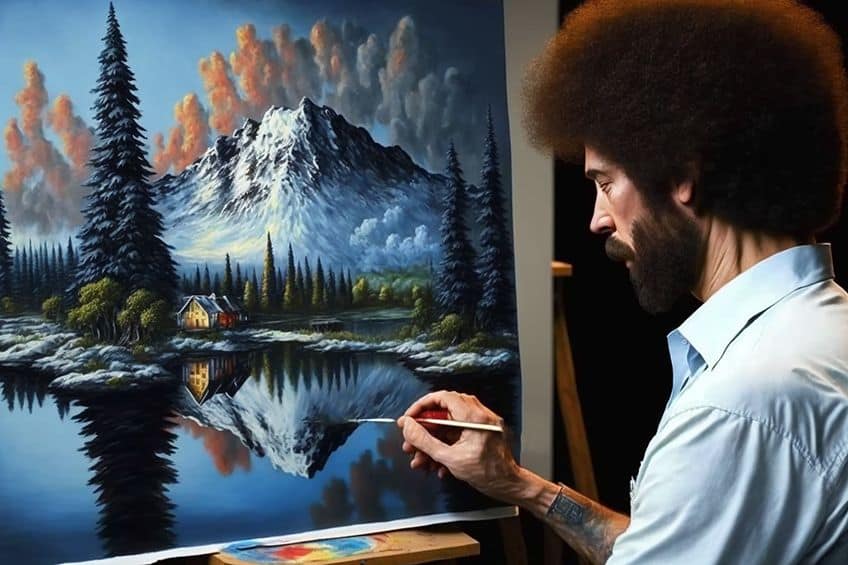How Did Bob Ross Die? – Learn More About the Beloved Painter
Everyone knows Bob Ross as the cheerful artist on television who brought joy to households across the country with his delightful painting lessons. Yet, when he passed away, it was under rather tragic circumstances and marred by controversies around his estate. But, how did Bob Ross die, and what happened to Bob Ross’ estate after his passing? Read further below, as we answer questions, such as “When did Bob Ross die?”, “How old was Bob Ross when he died?”, and “What was Bob Ross’ cause of death?”.
How Did Bob Ross Die?
Bob Ross’ cause of death was lymphoma, a type of cancer. What year did Bob Ross die? He passed away on the 4th of July, 1995, following a few months of unsuccessfully fighting the cancer. It is known that the artist always believed that he would die at a relatively young age because he had smoked for the majority of his life and even suffered several heart attacks in his early 40s. This was not even his first bout with cancer, yet the second time he was diagnosed, it proved to be too much for his body to deal with. He was diagnosed in 1994, at a time when he was wrapping up his famous television series in which he painted various landscapes in an instructional manner. Those who regularly watched the show would have noticed his deteriorating state towards the end of the show’s run. Before we delve any more into his death and the controversies that surrounded it, let us first find out more about the famous painter himself.
The Life of Bob Ross
| Artist Full Name | Robert Norman Ross |
| Nationality | American |
| Date of Birth | 29 October 1942 |
| Date of Death | 4 July 1995 |
| Place of Birth | Daytona Beach, Florida, United States |
Bob Ross was born to Jack and Ollie Ross in Daytona Beach and raised in Orlando. His father worked as a carpenter and his mother served as a waitress. As a young boy, he was fond of nature and animals and often nursed wounded animals, such as snakes, armadillos, squirrels, and even alligators.
He dropped out of school in the ninth grade and went to work for his father as a carpenter, where he lost a part of his index finger in an accident.
Career in the Military
Aged 18, he entered the U.S. Air Force in 1961 and received a position as a medical records technician. He was the first sergeant of the Air Force base clinic in Alaska, where he first encountered the snow-capped mountains that would later become a recurrent theme in his works of art. During his short daily breaks at work, he began to hone his rapid painting skills due to the shortage of time in which to paint. He decided never to raise his voice again after he left the military after serving in roles that required him to be commanding and mean.
Painting Career
Ross spent 20 years working for the military, during which time he started taking painting lessons at the Anchorage U.S.O. club. The majority of the instructors had a preference for abstract art, which Ross often found himself at odds with. He wanted to know how to paint a tree, not hear what their abstract concept of a tree was. He was working as a bartender when he came across the television show hosted by Bill Alexander, a German artist. Called the Magic of Painting, Alexander used a wet-on-wet painting technique that allowed him to complete full paintings in a short amount of time.
This inspired Ross, who went on to carefully study this technique. He began taking novelty gold-mining pans and painting scenes of Alaska on them.
This proved to be so successful that he was eventually making a better income from his paintings than he was receiving from his work in the military. He left the military and moved to Florida, where he joined Alexander’s company and became a salesman for Alexander’s art supply business as well as an art tutor. Annette Kowalski had attended one of his art classes and persuaded Ross that he could potentially be very successful on his own. So, Bob Ross, his wife, and Annette combined their resources to start his own company, which initially wasn’t successful. A Virginian television station showed a videotape of one of his painting classes as a pilot episode in 1982, and 60 public broadcasting stations subsequently signed up for the show in its very first year.

He began producing a show in 1983 for a station in Muncie, Indiana. He eventually moved back to Florida, but would travel to Muncie to record episodes of the show every three months. He said that he did the show without payment and made his money from art supplies, videotapes, and books. The show ran from 1983 to 1994, but even after the last episode was aired, it would continue to be played by stations throughout the country. Ross made use of his show to market a line of art materials and video tapes, which grew into a $15-million business with the support of the Kowalskis.
What Happened to Bob Ross?
Bob Ross, quite obviously ill at the time, made his final public television appearance in 1995, where he was a guest on the very first episode of the children’s show The Adventures of Elmer and Friends. His cancer remained unknown outside of his immediate family and friends until after he died. He passed away on the 4th of July in 1995 and his remains were laid to rest at Woodlawn Memorial Park in Gotha, Florida.
By the time Ross passed away, he had amassed a vast painting empire. He developed a set of art materials, including palettes, brushes, and easels, in addition to instructional manuals, featuring his face on every package.
Based on the terms of the company, the passing away of any partner in Bob Ross Inc. would result in that person’s shares being distributed equally among the other partners. This ultimately meant that the Kowalskis became the company’s sole owners, as both Ross and his wife had passed away. The Kowalskis mostly just wanted to use Ross’s name to sell painting materials. They grew quite hostile towards his family before his death, apparently trying to persuade a very sick Ross to hand over rights to his estate before dying. Instead, he left his fortune and the rights to his image and name to his son and half-brother in his will.
The Kowalskis replied that almost everything the artist produced throughout his lifetime was “work for hire”, and so Ross had no authority to pass down his wealth to them, and they finally won the lawsuit. After the Kowalskis eventually retired, Joan Kowalski took over the firm, and she started merchandising the brand outside of its main industry of painting supplies, launching the mass marketing of his name in the 2010s. She also made a deal with Ross’ son and brother-in-law which allowed her to use his likeness again. In exchange, his son would be able to resume his art career again without being constantly threatened with a lawsuit, which is something he had put on hold since his father’s passing.
The Legacy of Bob Ross
Though television stations continued broadcasting repeats of Bob Ross’s show for a few more years after his passing, the artist and his creations gradually faded from public memory. He was soon reduced to a fond childhood memory of a generation who had grown up in the 1980s. The internet then suddenly brought the artist back from the dead. Bob Ross, Inc. signed a contract with the live-streaming site Twitch in 2015. The site intended to debut its brand with a marathon of his painting show that could be streamed online. They agreed, and he was once again back in the public eye.
He was discovered for the first time by an entirely new generation, some of whom were genuinely interested in art and others who simply wanted to unwind after a long, exhausting day at work.
Ross is now more popular than he has ever been. His long-term popularity can be attributed in part to the timeless quality of his message. In reality, his show was more about learning to have faith in yourself and enjoy the beauty of the natural environment than it was about just learning to paint. Ross’s image has entered popular culture, with his likeness parodied in shows, films, and video games such as The Boondocks, Family Guy, Smite, and Deadpool 2.
According to the site, 5.6 million people watched the marathon, which led to the creation of a weekly rerun of one season of the show every Monday. Given that over a thousand paintings were made for his show, the revived interest in Ross’s work raised the question of where his works of art might be found. In an investigative report, the Kowalskis confirmed that they still had all of them, but that they were stored without the usual care required for storing paintings safely and effectively.
The artist known to the world as Bob Ross exuded a very lovable persona and along with his famous permed curly hair, it was known that women adored him and that he was a bit of a lady’s man. He eventually grew to dislike his permed look, but kept it as it had been incorporated into his brand likeness. He was suspected to be pursuing an affair with the partner of his company, which his son verified after overhearing his stepmother and father arguing. However, Bob Ross was a much-loved artist and television personality. Despite the controversies that surrounded his life, art enthusiasts continued to appreciate his paintings and videos.
Almost anybody who grew up in the 1980s would have heard of, or at least seen, the permed hair painter that once graced television stations across America. Known as Bob Ross, his iconic soothing voice and easy-to-follow painting style engaged audiences of all ages for many years, and most likely inspired many people to try their hand at painting. Originally working in the army, he eventually left to sell art supplies and teach painting, vowing to never again be in a job where he had to raise his voice. It was when his show started airing on public access channels across the country that he rose to fame. But what happened to Bob Ross? Unfortunately, the artist lost his battle with cancer in 1995, following legal battles with the remaining members of his company over the rights of his name and estate. However, despite this rather sad ending, his legacy lives on, and he is once again a recognized name after the successful marathon of his show on the streaming site, Twitch.
Frequently Asked Questions
When Did Bob Ross Die?
Bob Ross was most well-known for his incredibly popular show in which he taught the audience how to paint landscapes. Bob Ross aired his last episode in 1994, but what year did Bob Ross die? This renowned television celebrity and artist passed away on the 4th of July 1995. He died after battling lymphoma cancer for a short period of time. This was not his first bout with cancer, and he had previously also survived two heart attacks. He apparently always felt that he was going to pass away at a young age, mainly due to his excessive smoking habit.
How Old Was Bob Ross When He Died?
Bob Ross, the famous painter of landscapes who had a show on television in the 1980s, was 53 years of age when he passed away in 1995. He died from a type of cancer called lymphoma. While the painter was known for his positive demeanor and gentle voice, his last months alive were unfortunately filled with much distress due to his business partners, who were trying their best to take complete control of his company, as well as ownership of his entire estate. In his will, he left his brand and estate to his son. However, his partners eventually managed to win a court case to take over his estate.
Jordan Anthony is a Cape Town-based film photographer, curator, and arts writer. She holds a Bachelor of Art in Fine Arts from the University of the Witwatersrand, Johannesburg, where she explored themes like healing, identity, dreams, and intuitive creation in her Contemporary art practice. Jordan has collaborated with various local art institutions, including the KZNSA Gallery in Durban, the Turbine Art Fair, and the Wits Art Museum. Her photography focuses on abstract color manipulations, portraiture, candid shots, and urban landscapes. She’s intrigued by philosophy, memory, and esotericism, drawing inspiration from Surrealism, Fluxus, and ancient civilizations, as well as childhood influences and found objects. Jordan is working for artfilemagazine since 2022 and writes blog posts about art history and photography.
Learn more about Jordan Anthony and about us.
Cite this Article
Jordan, Anthony, “How Did Bob Ross Die? – Learn More About the Beloved Painter.” artfilemagazine – Your Online Art Source. October 30, 2023. URL: https://artfilemagazine.com/how-did-bob-ross-die/
Anthony, J. (2023, 30 October). How Did Bob Ross Die? – Learn More About the Beloved Painter. artfilemagazine – Your Online Art Source. https://artfilemagazine.com/how-did-bob-ross-die/
Anthony, Jordan. “How Did Bob Ross Die? – Learn More About the Beloved Painter.” artfilemagazine – Your Online Art Source, October 30, 2023. https://artfilemagazine.com/how-did-bob-ross-die/.





